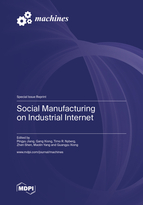Social Manufacturing on Industrial Internet
A special issue of Machines (ISSN 2075-1702). This special issue belongs to the section "Advanced Manufacturing".
Deadline for manuscript submissions: closed (30 November 2022) | Viewed by 34233
Special Issue Editors
Interests: networked digital manufacturing; service-oriented manufacturing systems engineering; RFID/ IOT; logistics engineering; product family design theory; collaborative engineering
Special Issues, Collections and Topics in MDPI journals
Interests: social manufacturing; industrial internet; cyber physical social system
Special Issues, Collections and Topics in MDPI journals
Interests: social manufacturing; industrial Internet; cyber physical social system
Interests: social manufacturing; industrial Internet; cyber physical social system
Interests: social manufacturing; industrial Internet; cyber physical social system
Special Issue Information
Dear Colleagues,
The fast development of the industrial Internet is boosting the evolution of the manufacturing industry to a new stage of socialization, servitization, universal interaction and connection, and platformization. Under this background, social manufacturing has emerged as a new kind of manufacturing paradigm established based on the self-driven, self-organized, self-adaptive, and cyber–physical–social interaction among huge numbers of socialized manufacturing resource providers. The most prominent advantage of social manufacturing is its capability to complete production/service orders with the limited internal manufacturing resources of an enterprise by utilizing socialized manufacturing resources from the outside, and this can be applied in both large and small enterprises and trigger value co-creation for both resource providers and demanders. To date, social manufacturing has drawn the attention of both the academic and industrial field due to its promising research and application values. However, social manufacturing is still in its infant stage as the fast development of the industrial Internet, artificial intelligence, collective intelligence, cloud/edge/fog computing, and the new generation of information and communication technologies are changing the interaction/configuration/operational mechanisms of social manufacturing every day.
In this regard, this Special Issue aims at exploring a wide range of topics related to social manufacturing on/over the industrial Internet, from the debating of its conation and concept architecture to its key enabling technologies and application verification. In this Special Issue, original research articles and reviews are welcome. Research areas may include (but are not limited to) the following:
- The debating of the conation and concept architecture of social manufacturing on/over the industrial Internet.
- The interaction/configuration/operation architecture of social manufacturing from multiple manufacturing resource dimensions such as equipment level, production line level, factory level, and cross factory level.
- The intelligent and interconnected equipment that supports machine–machine and human–machine interaction in the industrial Internet environment of social manufacturing.
- The application of advanced technologies that support interaction, configuration, and operation in the context of social manufacturing, such as CPSS, big data analysis, industrial Internet of Things, block chain, artificial intelligence, and digital twins.
- Novel industrial Internet oriented distributed software models for social manufacturing.
- Case studies of social manufacturing in both testbeds and real industrial scenarios, especially in large and complex manufacturing systems.
We look forward to hearing from you.
Prof. Dr. Pingyu Jiang
Guest Editor
Prof. Dr. Gang Xiong
Prof. Dr. Timo R. Nyberg
Prof. Dr. Zhen Shen
Dr. Maolin Yang
Prof. Dr. Guangyu Xiong
Co-Guest Editors
Manuscript Submission Information
Manuscripts should be submitted online at www.mdpi.com by registering and logging in to this website. Once you are registered, click here to go to the submission form. Manuscripts can be submitted until the deadline. All submissions that pass pre-check are peer-reviewed. Accepted papers will be published continuously in the journal (as soon as accepted) and will be listed together on the special issue website. Research articles, review articles as well as short communications are invited. For planned papers, a title and short abstract (about 100 words) can be sent to the Editorial Office for announcement on this website.
Submitted manuscripts should not have been published previously, nor be under consideration for publication elsewhere (except conference proceedings papers). All manuscripts are thoroughly refereed through a single-blind peer-review process. A guide for authors and other relevant information for submission of manuscripts is available on the Instructions for Authors page. Machines is an international peer-reviewed open access monthly journal published by MDPI.
Please visit the Instructions for Authors page before submitting a manuscript. The Article Processing Charge (APC) for publication in this open access journal is 2400 CHF (Swiss Francs). Submitted papers should be well formatted and use good English. Authors may use MDPI's English editing service prior to publication or during author revisions.
Keywords
- social manufacturing
- industrial Internet
- manufacturing system
- intelligent and interconnected equipment
- cyber physical social system
- artificial intelligence
- industrial Internet of Things
- digital twins








